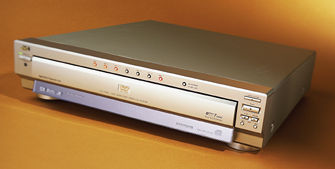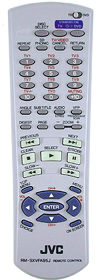MP3 Via DVD
Not content merely to conquer the world, the DVD player is rapidly becoming the Swiss army knife of consumer electronics. The list of formats it supports is already swollen: DVD-Video, Dolby Digital, Dolby Surround, DTS, the videoCD format that's so popular in Asia, and (of course) the CD, not to mention CD-Rs and CD-RWs. Gourmet formats like DVD-Audio, SACD, and even the obscure 24/96 stereo Digital Audio Disc are finding their way into affordable DVD players, as is a decidedly nongourmet format: MP3 compressed audio is coming to a DVD player near you.
For manufacturers, adding MP3 capability is a logical step in the evolution of do-it-all disc players. Reading the disc is not an issue. A DVD player whose pickup has been re-engineered with an extra laser diode to focus on less-reflective CD-R discs should be able to read MP3 data from those discs. Nor is there anything exotic about MP3, whose full name is MPEG-1, Layer 3. It originated as the soundtrack for the videoCD format, and VCD compatibility is already common in DVD players. The manufacturers' main challenge is not to enable MP3 playback but to provide a user interface that will allow the DVD player to duplicate PC functions like folder navigation.
For consumers, an MP3-enabled DVD player is certainly not a substitute for the flexibility that a good hard-drive-based, networked audio system provides. Still, it offers an easy way to add compressed-audio playback to a home theater system without having to add a new component. Once the signal is in the system, you can process it through various stereo-to-surround formats like Dolby Pro Logic II, DTS Neo:6, and Lexicon's Logic 7.
An MP3-enabled DVD player is a far-better system solution than just patching in a portable MP3 player. The average flash-memory portable has a capacity of just 64 to 128 megabytes, which is only about 10 to 20 percent as much memory as a single CD-R. Portable hard drives and CD players that play MP3-encoded CD-Rs don't suffer from that limitation, but they do degrade an MP3's already-minimal sound quality with puny preamp and volume-control circuitry. Even an average home theater system sporting an entry-level DVD player can easily make your MP3-encoded CD-Rs sound better.
Questions, Answers
"How much better?" was the main question on my mind when I asked several manufacturers to send me an MP3-capable DVD player of their choice. There were other questions, too. Would the interface require a video display? Could the player navigate to files stored within folders? How many keystrokes would it take to find and play a track? Given that you can encode MP3s at different bit rates, how many bit rates would the player support?
I started by making a test disc of a familiar track with plenty of high-frequency bite. It had to be something that I could listen to dozens of times without coming to hate it. The winner was "Taxman," Beatle George's lead track from the Revolver CD. I used MusicMatch software to rip it at 96, 128, and 160 kilobits per second. (The optimum blend of efficiency and sound quality is to be found somewhere between 128 and 160 kbps. Whenever I have a choice, I use 160.)
My review system was a receiver-based real-world rig. After all, I was testing MP3 capability, not SACD. It consisted of RBH's compact but formidable CT-5 speakers and MS-8.1 subwoofer ($1,099). The surround receiver was Arcam's superb AVR200 ($1,199). I did the brief, critical listening tests in stereo and then reverted to my now-normal preference of Dolby Pro Logic II for additional casual listening. Cables included vintage Monster PowerLine2+ speaker cable and MIT analog and digital interconnects. (The analog cables were necessary because at least one player would only play MP3s through its analog outputs.) To view the onscreen menus, I used an old 19-inch Proton composite video monitor, while a Zenith DSV-110 DLP projector (with a 25-foot Tributaries S-video cable) served for movie watching.
JVC XV-FA95GD
JVC's XV-FA95GD ($500) is a clever changer with an elaborate fold-under carousel mechanism that squeezes seven discs into a space where most other manufacturers could fit no more than five. In addition to MP3 capability, this progressive-scan model plays DVD-Audio discs (but not SACDs). A big (and underpublicized) plus is the CompuLink system, which enables JVC components to send control signals to one another. Hook up this carousel to a JVC receiver, and you'll be able to power down your whole system with the press of one button.

Answers to some of my nagging questions came speedily. Yes, the XV-FA95GD could play MP3 files from CD-Rs. According to JVC, MP3 capability is a feature of the player's National Semiconductors NDV8601 chipset. (I asked all three manufacturers to discuss their MP3 implementation in silicon, but only JVC answered the question in detail.) MP3 playback was limited, however, to the analog line outputs. Normally, this isn't the best way to connect a DVD player to a receiver. Using one of the digital outputs is better because it lets you avoid unnecessary digital-to-analog and analog-to-digital stages: from digital to analog within the DVD player and from analog to digital within the receiver. However, the analog-out-only limitation won't be a problem if you set up the 5.1-channel line outputs for DVD-Audio listening, which—to prevent the music industry from throwing a tantrum—is also limited to the analog outs. You've already got to use the analog outputs for DVD-Audio, so you might as well use them for MP3, too.
 Yes, my test disc sounded better through the DVD player than it did through a portable hard drive (the cool Archos Jukebox Recorder) plugged into the same system—and way better than the subwoofer-enhanced speakers in my six-year-old Toshiba Infinia PC monitor. Using their proprietary pulse edge modulation (PEM) technology, JVC's traditionally excellent digital-to-analog conversion probably helped a lot. Even regular CDs sounded excellent through the analog outputs.
Yes, my test disc sounded better through the DVD player than it did through a portable hard drive (the cool Archos Jukebox Recorder) plugged into the same system—and way better than the subwoofer-enhanced speakers in my six-year-old Toshiba Infinia PC monitor. Using their proprietary pulse edge modulation (PEM) technology, JVC's traditionally excellent digital-to-analog conversion probably helped a lot. Even regular CDs sounded excellent through the analog outputs.
The XV-FA95GD's user interface is a mixed bag of strengths and weaknesses. JVC got off to an excellent start by including "MP3 disc playback" on the short list of page numbers on the manual's cover, so there's no need to read through the massive table of contents inside. The interface does require a video monitor. Navigating folders is an easy matter of scrolling through the onscreen menu, highlighting a desired folder or track, and pressing enter. Child's play.
 The onscreen display limits file names to 30 characters (by no means a shabby number, as we'll see later). No horizontal scrolling is available to read beyond that number. The logical workaround is to limit file names to fewer than 30 characters. If you get a lot of your music from file-sharing services—where, by necessity, fellow users tend to cram artist, album title, and song title onto the same line—you'll probably want to edit out everything but the song title and use folders to indicate artist and album title.
The onscreen display limits file names to 30 characters (by no means a shabby number, as we'll see later). No horizontal scrolling is available to read beyond that number. The logical workaround is to limit file names to fewer than 30 characters. If you get a lot of your music from file-sharing services—where, by necessity, fellow users tend to cram artist, album title, and song title onto the same line—you'll probably want to edit out everything but the song title and use folders to indicate artist and album title.
What did "Taxman" have to tell me? The most immediate revelation was that Sir Paul's pounding bass line had a powerful, unexpected physical presence in every format. Naturally, the cutting edge and inner detail of the massed Beatle voices grew stronger as I progressed from the 96-kbps version to the 128 and 160 versions. (In MusicMatch, the 160-kbps mode includes oversampling.) None of the MP3 files sounded as clean as the original CD track; however, even the lowliest one was about as listenable as, say, a Type I audiocassette.
In the end, I found only one insurmountable pet peeve with the XV-FA95GD: Those persistent flashing lights on the front-panel display were awfully distracting when I was watching movies.





























































